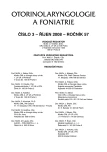Auditory Neuropathy
Authors:
M. Lejska; R. Havlík
Authors‘ workplace:
AUDIO-Fon centr, s. r. o., audiologie a foniatrie, Brno
přednosta doc. MUDr. M. Lejska, CSc.
Published in:
Otorinolaryngol Foniatr, 57, 2008, No. 3, pp. 165-172.
Category:
Case History
Overview
Auditory neuropathy (auditory dys-synchrony, AN/AD) is the name for a newly diagnosed independent nosological unit used in evaluating sensoric-neural defects of hearing. A common sensorineural hearing impairment classically originates as a damage of hair cells of inner ear with well-preserved function of auditory nerve. AN/AD is defined as an opposite condition. The existence of hair cells in cochlear is confirmed as well as their motor functionality in processing of auditory signal, but functionality of auditory nerve is severely damaged. The diagnosis if based on mutual comparison of two objective methods of examination – acoustic emissions (OAE) (particularly the transitory effect) and measurement of the stem evoked potentials (ABR). The stem potentials are always affected, which according present evaluation corresponds to very severe hearing defect or deafness. In contrast to that OAE are always fully equipped, therefore correspond to the finding in normal state of hearing.
The paper presents present knowledge of these special types of sensorineural hearing defects.
A similar type of hearing defect (normal OAE and simultaneously affected ABR) in the smallest children is most often encountered in those who suffered from perinatal damage: premature delivery, low birth weight, asphyxia etc. From the AN/AD conclusions is follows, as is presently considered as standard in the world (especially in the U.S.A.) is to examine, while determining hearing state in the smallest children, in a combination of OAE and ABR. The use of a single method only, although quite widespread, is apparently insufficient based on the AN/AD knowledge and could result in a significant distortion of results evaluating hearing state in the smallest children.
Key words:
auditory neuropathy, auditory nerve, otoacoustic emissions, stem-evoked potentials.
Sources
1. Bendová, O.: Auditory neuropathy. Přednáška, 45.otologický den, Praha, 1. 12. 2005.
2. Berlin, C. I., Hood, L. J., Cecola, R. P., Jackson, D. F., Szabo, P.: Does Type I afferent neuron dysfunction reveal itself throug lack efferent suppresion ? Hearing Reaserch, 65, 1993, s. 40-50.
3. Berlin, C. I., Bordelon, J., St. John, P., Wilensky, D., Hurley, A., Kluka, E.: Reversing click polarity may uncover Auditory neuropathy in infants. Ear and Hearing, 19, 1998, s. 37-47.
4. Berlin, C. I.: Managing patients with Auditory neuropathy/Dys-synchrony. (1999).
5. Doyle, K. J., Sininger, Z., Starr A.: Auditory neuropathy in childhood. Laryngoskope, 108, 1998, s. 1374-1377.
6. Gibson,W. P., Santi, H.: Auditory neuropathy: an update. Ear and Hearing, 28 (2. Suppl), 2007, s. 102-106.
7. Gorga, M. P.., Stelmachowicz, P. G., Barlow, S. M., Brookhouser, R. E.: Cases of recurrent, reversible, sudden sensoneural hearing loss in a child. Journal of the American Academy of Audiology, 6, 1995, s. 163-172.
8. Gravel, J. S., Stapells, D. R.: Behavioral, electrophysiologic and otoacoustic measures for a child with auditory processing dysfunction. Journal of the American Academy of Audiology, 4, 1993, s. 412-419.
9. Hain, T. C.: Auditory neuropathy. (2007).
10. Hood, J. L.: Auditory neuropathy: What is it and what can we do ab it ? The Hearing Journal, 51, 1998, 8.
11. Hood, J. L.: Auditory neuropathy/Auditory Dys-synchony. Audiology Awareness Camplaign, 1999.
12. Kraus, N., Oazdar, O., Stein, L., Reed, N.: Absent auditory brainstem response: Peripheral hearing loss or brain stem dysfuncion ? Laryngoscope, 94, 1984, s. 400-406.
13. Lee, K. C., Tami, T. A.: Otolaryngologic manifestatiton of HIV. (1998).
14. Lejska, M.: Auditory neuropathy. Přednáška. Seminář firmy Audifon, Böhmischbrücke SRN, 22. - 24. 4.2005.
15. Liang, F.: Auditory neuropathy: clinical study of 17 cases. ARO abstracts, 53, 2001.
16. Madden, C.: Clinical and audiological features in auditory neuropathy. Arch Otolaryngol, 2002, s. 1026-1030.
17. Sininger, Y. S.., Hood, L. J., Starr, A., Berlin, C. I..: Hearing loss due to auditory neuropathy. Auditory Today, 7, 1995, s. 10–13.
18. Sinninger, Y. A.: Implication of auditory neuropathy in the audiologic diagnostic process for infants. The 3th Widex Congres of Paediatric Audiology, 24. - 26. 5. 2004, Copenhagen, Denmark.
19. Starr, A., McPherson, D., Patterson, J., Don, M., Luxford, W., Shannon, R., Sin, Y., Tonokawa, L., Waring, M.: Absence of both auditory evoked potentials and auditory percepts depending on timming cues. Brain, 114, 1991, s. 1157-1180.
20. Starr, A., Picton, T. V., Sininger, Y. S., Hood, L. J., Berlin, C. I.: Auditory neuropathy. Brain, 119, 1996, s. 741-753.
21. Wang, Q., Gu, R., Han, D., Yang, W.: Familial auditory neuropathy. Laryngoskope, 113, 2003, 9, 2003, s. 1623–1629.
Labels
Audiology Paediatric ENT ENT (Otorhinolaryngology)Article was published in
Otorhinolaryngology and Phoniatrics

2008 Issue 3
Most read in this issue
- Extraesophageal Reflux (Part 2) ORL Manifestation and Therapy
- Middle Ear Inflammation on the Basis of Chronic Purulent Middle Ear Inflammation with Cholesteatoma
- Extraesophageal Reflux (Part 1) Epidemiology, Pathophysiology and Diagnostics
- Auditory Neuropathy
